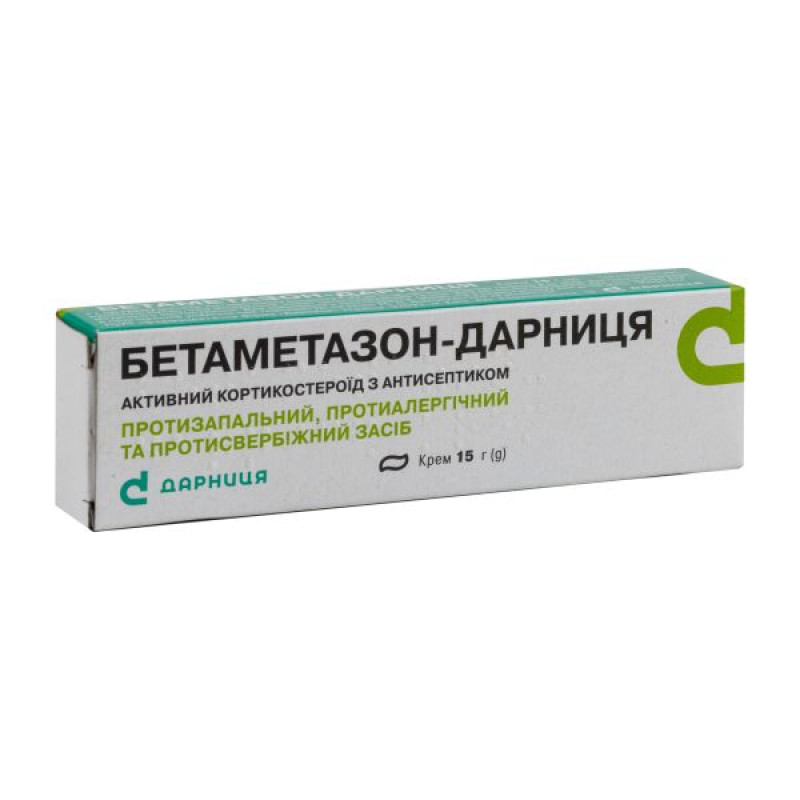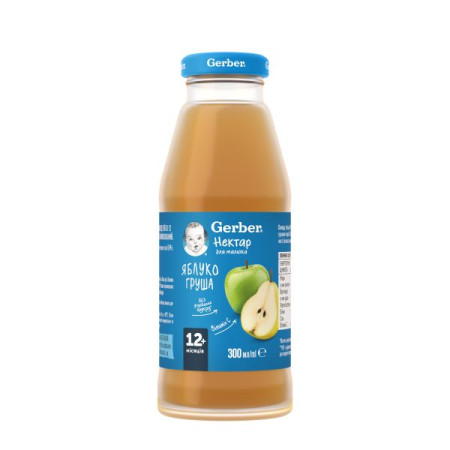Betamethasone-Darnitsa cream tube 15 g

Instructions Betamethasone-Darnitsa cream tube 15 g
Composition
active ingredients: betamethasone, ethylpyridinium;
1 g of cream contains betamethasone valerate 1.22 mg, cetylpyridinium chloride 4 mg;
Excipients: propylene glycol, mineral oil, cetostearyl alcohol, disodium edetate, purified water.
Dosage form
Cream.
Main physicochemical properties: homogeneous white cream, odorless.
Pharmacotherapeutic group
Active corticosteroids in combination with antiseptics. Betamethasone and antiseptics. ATX code D07B CO1.
Pharmacological properties
Betamethasone valerate, which is part of the drug, has a local anti-inflammatory, anti-allergic, antipruritic and anti-exudative effect.
Cetylpyridinium chloride has a bacteriostatic and fungistatic effect, as a result of which the drug prevents the development of secondary infection.
Indication
Reduction of inflammatory manifestations of dermatoses sensitive to glucocorticosteroid therapy, such as: eczema (atopic, nummular), neurodermatitis, dermatitis (contact, solar, seborrheic, exfoliative, radiation, intertriginous, stasis dermatitis), psoriasis (except widespread psoriasis), anogenital and senile pruritus.
Contraindication
Hypersensitivity to the active substances or to other components of the drug; bacterial, viral, fungal skin infections (including herpes simplex and herpes zoster, chickenpox, tuberculosis and syphilis of the skin), post-vaccination skin reactions, rosacea, rosacea-like (perioral) dermatitis.
The drug is not intended for ophthalmic use.
Interaction with other medicinal products and other types of interactions
There are no data on the interaction of the drug with other drugs or other types of interactions.
However, the drug is not recommended for use simultaneously with topical forms of drugs, in particular those containing anionic surfactants that inactivate the action of cetylpyridinium chloride.
Due to the presence of mineral oil in the excipients, the use of the drug in the anogenital area may damage the structure of latex condoms and reduce their safety during use.
In cases where systemic absorption of betamethasone can be anticipated, numerous interactions with other drugs should be borne in mind.
Application features
The drug is not intended for use in ophthalmology (in the eyes, around the eyes).
Prolonged use of the drug on the skin of the face should be avoided.
Caution should be exercised when applying the drug near the face and avoid contact with the eyes and mucous membranes.
The drug is not recommended for use under occlusive dressings and/or on large areas of skin (high doses) and/or for a long time (more than 3-4 weeks) due to systemic absorption of betamethasone.
Systemic absorption of topical corticosteroids increases with dosage. Corticosteroids with high potency on large areas of skin should be used under close medical supervision and with periodic monitoring of the patient's condition, since they can cause suppression of the hypothalamic-pituitary-adrenal (HPA) axis. HPA function is usually restored when the drug is discontinued. In some cases, withdrawal symptoms may develop, requiring the addition of a systemic corticosteroid. If suppression of the HPA axis develops, the frequency of application should be reduced or the drug should be discontinued and the patient transferred to a less potent corticosteroid.
If skin irritation or signs of hypersensitivity occur, discontinue use and consult a doctor.
In the event of fungal or bacterial superinfection of the skin, additional use of an antifungal or antibacterial agent is necessary. If the desired effect does not occur quickly, the use of corticosteroids should be discontinued until the signs of infection have resolved.
Use during pregnancy or breastfeeding
Do not use the drug during the first trimester of pregnancy.
The drug should only be prescribed in later stages of pregnancy and when the expected benefit to the expectant mother clearly outweighs the potential risk to the fetus. Drugs of this group should not be used by pregnant women in high doses, for a long time, or under occlusive dressings.
It is currently unknown whether topical corticosteroids, due to systemic absorption, can lead to their penetration into breast milk, therefore, when making a decision to discontinue breastfeeding or discontinue the drug, the importance of therapy to the mother should be taken into account.
Ability to influence reaction speed when driving vehicles or other mechanisms
Usually, the drug does not affect the patient's reaction speed when driving or using other mechanisms.
Method of administration and doses
The drug is used externally. The cream is applied in a thin layer to the affected skin surface 1-3 times a day, depending on the severity of the condition. The frequency of application depends on the degree of damage: with a mild degree, the drug can be applied 1 time a day, in case of severe damage, the frequency of application of the drug must be increased. In most cases, to achieve the effect, it is enough to apply the drug 1-2 times a day.
Do not use the drug under occlusive dressings, as the side effects of the drug may be increased.
Continuous use of the drug should not exceed 4 weeks. If the patient's condition does not improve or worsens within 2-4 weeks of therapy, a re-examination should be performed and the treatment reviewed.
Children
The safety of the drug in children has not been established, therefore the drug is not intended for use in this category of patients.
Overdose
Symptoms: Excessive or prolonged use of topical corticosteroids may cause suppression of pituitary-adrenal function, leading to secondary adrenal insufficiency and symptoms of hypercorticism, including Cushing's syndrome. Acute symptoms of hypercorticism are usually reversible.
Treatment: symptomatic therapy, if necessary, correction of electrolyte balance. In case of chronic toxic effects, gradual withdrawal of the drug is recommended.
Adverse reactions
On the part of the immune system, skin and subcutaneous tissue: hypersensitivity reactions, burning and/or tingling sensation of the skin, feeling of warmth, itching, irritation, dryness, cracking, lamellar and/or focal peeling of the skin, erythema, telangiectasia, folliculitis, follicular rashes, acneiform rashes, hypertrichosis, sweating, hypopigmentation, rosacea-like (perioral) dermatitis, allergic contact dermatitis, skin induration, skin maceration, skin atrophy, striae, secondary infection.
On the part of the endocrine system: suppression of the hypothalamic-pituitary-adrenal system with the development of secondary adrenal insufficiency, symptoms of hypercorticism, Itsenko-Cushing's syndrome.
Any side effects that occur with systemic use of glucocorticosteroids, including suppression of adrenal cortex function, may also occur with their topical use, especially in high doses, for long periods of time, under occlusive dressings, and in children.
Adrenal suppression, Cushing's syndrome, growth retardation, failure to gain weight, and intracranial hypertension have been reported in children receiving topical corticosteroids. Symptoms of adrenal suppression in children include low plasma and urinary cortisol levels and unresponsiveness to adrenocorticotropic hormone stimulation. Manifestations of intracranial hypertension include fontanelle bulging, headache, and bilateral optic nerve edema.
Expiration date
2 years.
Storage conditions
Store in the original packaging at a temperature not exceeding 25 °C.
Keep out of reach of children.
Packaging
15 g or 30 g in a tube; 1 tube in a pack.
Vacation category
According to the recipe.
Producer
PrJSC "Pharmaceutical Company "Darnitsa".
Location of the manufacturer and its business address
Ukraine, 02093, Kyiv, Boryspilska St., 13.
There are no reviews for this product.
There are no reviews for this product, be the first to leave your review.
No questions about this product, be the first and ask your question.













